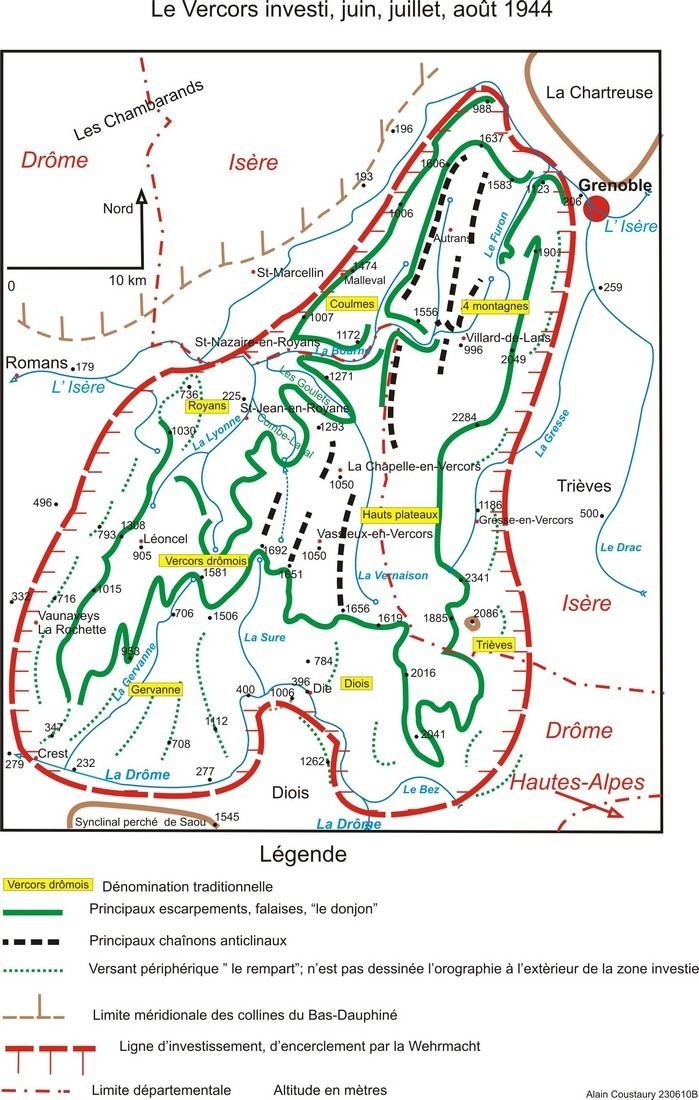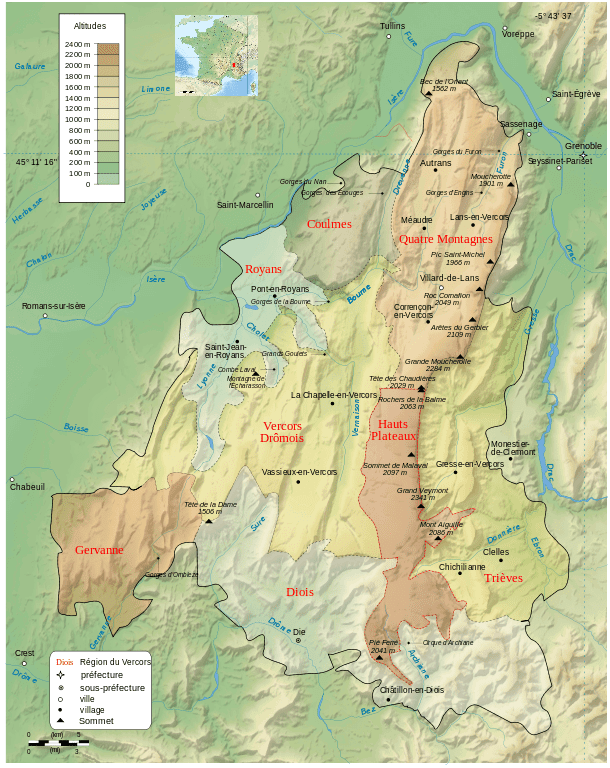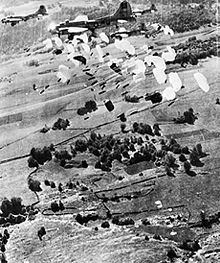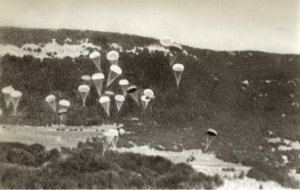639 killed (+ 201 civilians killed) 350 killed | ||
 | ||
Similar French Forces of the Interior, Free France, Free French Forces, Organisation de résistanc, Chasseurs Alpins | ||
The Maquis du Vercors was a rural group of the French Forces of the Interior resistance (maquis) that fought the 1940–1944 German occupation of France in World War II. The Maquis du Vercors used the prominent scenic plateau known as the Massif du Vercors (Vercors Plateau) as a refuge. Many members of the maquis, known as maquisards, died fighting in 1944 in the Vercors Plateau.
Contents

Events of 1944

From 16 to 24 April 1944 the Milice (a Vichy government paramilitary militia) attacked the village of Vassieux, burning several farms and shooting or deporting some of the inhabitants. Nevertheless, the local population continued to support the Resistance movement.

On 5 June 1944 the Free French government in London called upon the people of Vercours to take up arms and tie down the German army, prior to the Allied invasion of Normandy as part of a wider series of resistance uprisings. In his BBC speech, de Gaulle pronounced the famous line "le chamois des Alpes bondit" ("the chamois of the Alps leaps forth") which signalled the 4,000 maquisards to begin the uprising.

To overcome the centre of resistance around Vassieux-en-Vercors, Luftlandgeschwader 1 landed two companies of Russian and Ukrainian troops of Fallschirm-Battalion "Jungwirth" of the Brandenburg Lehr Battalion by DFS 230 and Gotha Go 242 gliders on 23 July.

The bloody suppression of the Vercors insurrection further inflamed the Maquis in the region, but also served as a warning that they were not well enough armed or organized to directly confront the Wehrmacht until the arrival of the Allies. The Maquis returned to the more traditional style of petite guerre ("little war"), engaging in harassment and ambush of Wehrmacht units rather than large-scale tactical operations.
Order of battle

According to the order of battle of 8 July 1944 from General Niehoff, Kommandant des Heeresgebietes Südfrankreich (military region of southern France), about operation Bettina against Maquis du Vercors, it appears that the Germans deployed nearly 10,000 soldiers and policemen under General Karl Pflaum:
Almost all the 157. Reserve-Division of the Wehrmacht: 4 reserve mountain light infantry battalions (Btl. I./98, II./98, 99 and 100 from the Reserve-Gebirgsjäger-Regiment 1); 2 reserve infantry battalions (Btl. 179 and 199 from the Reserve-Grenadier-Regiment 157 – Btl. 217 remained in the southern Alps at Embrun); 2 reserve artillery batteries (from Res.Geb.Art.Abt. 79 out of the Reserve-Artillerie-Regiment 7).
Other units: Kampfgruppe « Zabel » (1 infantry battalion from the 9. Panzer-Division and 1 Ost-Bataillon); 3 Ost-Bataillonen (Ostlegionen); about 200 Feldgendarmen; 1 security battalion (I./Sicherungs-Regiment 200); 1 police battalion (I./SS-Polizei-Regiment 19); about 400 paratroopers (special units from Fallschirm-Kampfgruppe Schäfer).
According to the daily reports of OB West on 23 and 24 July 1944, forwarded by the Militärbefehlshaber in Frankreich, the following troops landed at Vassieux-en-Vercors on 21 and 23 July 1944:
On 21 July 1944 about 200 men from Fallschirmjäger-Bewährungstruppe (probationary troops) forming the Fallschirm-Kampfgruppe « Schäfer », with several French volunteers (from the Sipo-SD of Lyons or from the 8th company of the 3rd regiment « Brandenburg »), were airborne in 22 DFS-230 gliders (each with 1 pilot and 9 soldiers) towed by bombers Dornier-17 out of I/Luftlandegeschwader 1, from Lyons-Bron to Vassieux-en-Vercors. According to Peter Lieb, two gliders crashed and eight of them landed a bit further on, so the first wave of assault consisted only of about a hundred soldiers.
Peter Lieb spécifies that the Kommandeur der Sipo-SD of Lyon (KDS), SS-Obersturmbannführer (SS Lieutenant Colonel) Werner Knab, was also airborne on Vassieux on 21 July. Shot and wounded, he was evacuated in a Fieseler Fi 156 Storch on 24 July. He would have played an important part in the torture and the slaughter of the Maquisards of Vercors and the inhabitants of Vassieux.
On 23 July 1944, 3 Go-242 gliders (each with 2 pilots and 21 soldiers, or weaponry and supplies), towed by bombers Heinkel-111, and 20 DFS-230 gliders transported one Ost-Kompanie (Ostlegionen: Russian, Ukrainian and Caucasian volunteers) and a paratrooper platoon from Valence-Chabeuil to Vassieux. According to Peter Lieb, at least two DFS-230 and two Go-242 gliders landed a further on, only one Go-242 with weaponry and supplies landed on Vassieux, so the second wave of assault consisted only of about a hundred and fifty soldiers.
Thomas and Ketley wrote that the Fallschirm-Kampfgruppe « Schäfer » was detached from Kampfgeschwader 200 on 8 June 1944. It was made up of volunteers out of Fallschirmjäger-Bewährungstruppe (probationary troops), mustered at Tangerhütte and trained for three months at Dedelstorf in order to launch an attack from gliders. Günther Gellermann says that the Fallschirm-Kampfgruppe « Schäfer » was under Luftflotte 3 command and no longer under Kampfgeschwader 200 command.
Republic of Vercors
This followed the declaration of freedom from the German occupation in some towns and villages on the plateau. On 3 July 1944 the Free Republic of Vercors was proclaimed, the first democratic territory in France since the beginning of the German occupation in 1940. The Free Republic had its own flag, i.e., the French Republic tricolour featuring the Cross of Lorraine and the "V" for Vercors and Victory (both used as a signature by General Charles de Gaulle's Free French Forces), and its coat of arms, the French Alpine Chamois. It was a short-lived regime; it ceased to exist before the end of the month.
Maquisards appealed to Free French agencies based in London and Algiers to supply them with more arms and heavier weaponry to counter the German action, but none were forthcoming. "We shall not forget the bitterness of having been abandoned alone and without support in time of battle," wired the French Forces of the Interior (FFI) commander to London.
It has been suggested that General Charles de Gaulle and others had political motives for failing to support the Vercors uprising, although the logistical difficulties for the Allies in sending supplies when the war effort was concentrated on D-Day probably had more influence.
In fiction
The Maquis du Vercors is depicted and veterans act in Pierre Schoendoerffer's 2002 feature film Above the Clouds (Là-Haut), and in the third season of the British TV programme Wish Me Luck, which first aired in 1990. The battle and the maquisards of Vercors also prominently feature in Frank Yerby's 1974 novel The Voyage Unplanned.
Documentary film
French director Jean-Paul Le Chanoi made Au Coeur de l'Orage (In the Heart of the Thunderstorm), a documentary about the French Resistance during the Second World War, in 1948. The movie, composed of Allied clandestine film recordings and German newsreel, focuses on the battle of the Vercors Plateau during July 1944.
In 2011 the Belgian TV channels RTBF and VRT broadcast a documentary film by André Bossuroy, addressing the memory of the victims of Nazism and of Stalinism ICH BIN, with support from the Fondation Hippocrène and from the EACEA Agency of the European Commission (Programme Europe for citizens – An active European remembrance), RTBF, VRT. Four young Europeans meet with historians and witnesses of our past… They investigate the events of the Second World War in Germany (the student movement of the White Rose in Munich), in France (the Vel' d'Hiv Roundup in Paris, the resistance in Vercors) and in Russia (Katyn Forest massacre).
